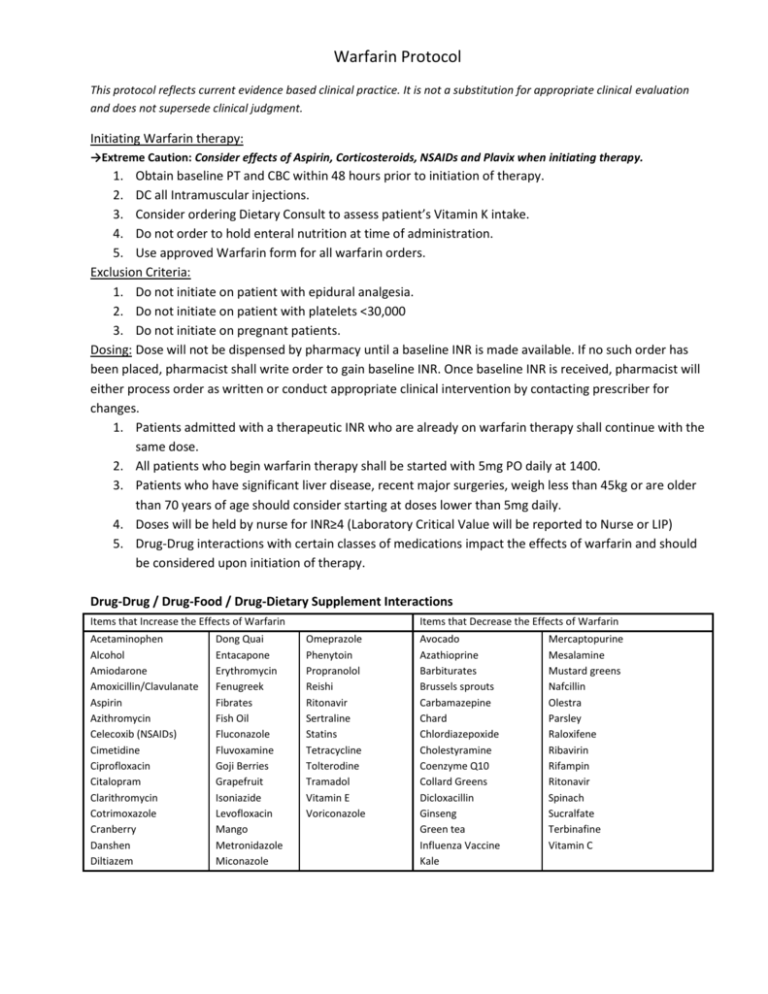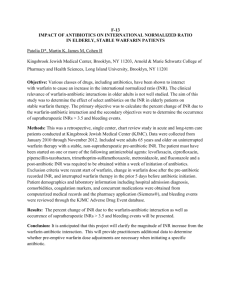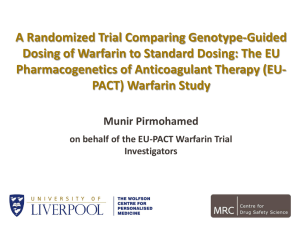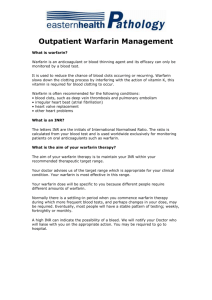Warfarin Protocol
advertisement

Warfarin Protocol This protocol reflects current evidence based clinical practice. It is not a substitution for appropriate clinical evaluation and does not supersede clinical judgment. Initiating Warfarin therapy: →Extreme Caution: Consider effects of Aspirin, Corticosteroids, NSAIDs and Plavix when initiating therapy. 1. Obtain baseline PT and CBC within 48 hours prior to initiation of therapy. 2. DC all Intramuscular injections. 3. Consider ordering Dietary Consult to assess patient’s Vitamin K intake. 4. Do not order to hold enteral nutrition at time of administration. 5. Use approved Warfarin form for all warfarin orders. Exclusion Criteria: 1. Do not initiate on patient with epidural analgesia. 2. Do not initiate on patient with platelets <30,000 3. Do not initiate on pregnant patients. Dosing: Dose will not be dispensed by pharmacy until a baseline INR is made available. If no such order has been placed, pharmacist shall write order to gain baseline INR. Once baseline INR is received, pharmacist will either process order as written or conduct appropriate clinical intervention by contacting prescriber for changes. 1. Patients admitted with a therapeutic INR who are already on warfarin therapy shall continue with the same dose. 2. All patients who begin warfarin therapy shall be started with 5mg PO daily at 1400. 3. Patients who have significant liver disease, recent major surgeries, weigh less than 45kg or are older than 70 years of age should consider starting at doses lower than 5mg daily. 4. Doses will be held by nurse for INR≥4 (Laboratory Critical Value will be reported to Nurse or LIP) 5. Drug-Drug interactions with certain classes of medications impact the effects of warfarin and should be considered upon initiation of therapy. Drug-Drug / Drug-Food / Drug-Dietary Supplement Interactions Items that Increase the Effects of Warfarin Acetaminophen Alcohol Amiodarone Amoxicillin/Clavulanate Aspirin Azithromycin Celecoxib (NSAIDs) Cimetidine Ciprofloxacin Citalopram Clarithromycin Cotrimoxazole Cranberry Danshen Diltiazem Dong Quai Entacapone Erythromycin Fenugreek Fibrates Fish Oil Fluconazole Fluvoxamine Goji Berries Grapefruit Isoniazide Levofloxacin Mango Metronidazole Miconazole Items that Decrease the Effects of Warfarin Omeprazole Phenytoin Propranolol Reishi Ritonavir Sertraline Statins Tetracycline Tolterodine Tramadol Vitamin E Voriconazole Avocado Azathioprine Barbiturates Brussels sprouts Carbamazepine Chard Chlordiazepoxide Cholestyramine Coenzyme Q10 Collard Greens Dicloxacillin Ginseng Green tea Influenza Vaccine Kale Mercaptopurine Mesalamine Mustard greens Nafcillin Olestra Parsley Raloxifene Ribavirin Rifampin Ritonavir Spinach Sucralfate Terbinafine Vitamin C Warfarin Protocol Adjusting Initial Warfarin Dose: The following table may be used as a guideline in changing warfarin doses after initiation of warfarin therapy. Day INR Warfarin Dose (mg) 2 < 1.5 1.5-1.9 2-2.5 >2.5 5 2.5 1 HOLD 3 < 1.5 1.5-1.9 2-3 >3 5-10 2.5-5 0-2.5 HOLD 4 < 1.5 1.5-1.9 2-3 >3 10 5-7.5 0-5 HOLD Adjusting Existing Warfarin Regimen: The following table may be used as a guideline in changing warfarin doses on a patient who has been on a therapeutic regimen for a target INR 2-3. INR ACTION: TWD (Total Weekly Dose) 1-1.4 Increase TWD by 15-25%; Give extra dose for 2 days. 1.5-1.9 Increase TWD by 10-15%; Give extra dose for 1 day. 2-3 Maintain TWD 3.1-4 Decrease TWD by 10-15%; Hold dose for 1 day. 4.1-5 Decrease TWD by 15-25%; Hold dose for 2 days. >5 Decrease TWD by 25-30%; Hold until INR < 3 Monitoring: 1. Obtain daily PT with AM Labs until INR goal is therapeutic and stable ≥ 2 days, thereafter less frequently as clinically indicated. 2. Obtain CBC daily with AM Labs. Goal INRs per Indication: 1. 2. 3. 4. Indication INR Target 1. Antiphospholipid Antibody Syndrome 2. Atrial Fibrillation 3. DVT/PE Treatment and Prophylaxis 4. Mechanical valves in aortic position 2-3 1. Mechanical valves in mitral positions. 2.5-3.5 1. “High Risk” patients with Mechanical valves in the aortic position. 2. “High Risk” patients with bioprosthetic valves in the mitral position. High Risk: Patients with Atrial fibrillation, prior embolus, LA or LV clot, severe LV dysfunction (EF<30%), hypercoagulable state and coronary artery disease. Warfarin Protocol Bridge Therapy: Converting patient from all anti-coagulants to warfarin (with exception of Argatroban) 1. For those with active clot or high risk for clotting, there must be a five day overlap of both drugs. 2. Achieve therapeutic INR ≥ 2 days prior to stopping the Heparin, Lovenox or Arixtra. Reversal Agents: Correction of INR INR Action INR < 5 (No significant bleeding) Hold dose. Resume at a lower dose when the INR is therapeutic. 5-9 (No significant bleeding) Hold next 1-2 doses. Resume at a lower dose when the INR is therapeutic. Alternatively, hold 1 dose, administer Vitamin K 1-2.5 mg PO x 1 5-9 (No significant bleeding) Urgent Surgery Needed Administer Vitamin K 2-4 mg PO to decrease INR within 24 hours. May give additional 12mg PO x 1 if INR remains elevated. Alternatively, administer Vitamin K 2-4mg IV over 60 minutes for faster reversal with FFP for imminent surgical candidates. INR > 9 (No significant bleeding) Administer Vitamin K 3-5mg PO x 1. INR should decrease over the next 24 hours. Administer additional Vitamin K if needed. Resume warfarin at a lower dose when INR is therapeutic. INR >20 with serious bleeding Hold warfarin. Give Vitamin K 10mg IV over a minimum of 60 minutes. FFP is indicated if reversal is needed sooner than 4 hours. Vitamin K may be repeated every 12 hours (to a maximum dose of 30mg). Life-threatening bleeding (e.g. intracranial hemorrhage) Hold warfarin. Administer FFP along with Vitamin K 5-10mg IV over a minimum of 60 minutes. Consider using Recombinant Factor VII or “Prothrombin Complex Concentrate (PCC)“ Vitamin K (phytonadione): Appropriate Use Oral is the preferred route and corrects INR within 24-48 hours. Subcutaneous route is not effective and should not be used. Intravenous delivery is the fastest and most reliable route. There are many potential side effects to consider with this route of administration. Infusing Vitamin K over 60 minutes is the key to avoiding adverse effects. DO NOT USE IV Vitamin K in patients with prosthetic valves because of the increased risk of thromboembolism. References: Commission, T. J. (2008). Medication Use: A Systems Approach to reducing Errors, 2nd Edition. Oakbrook Terrace, IL. Institute of Safe Medication Practices. (2011). Retrieved from www.ismp.org Joint Commission Resources. (2011). Retrieved from www.jcrinc.com Practices, I. f. (2005). ISMP Medication Safety Self Assessment for Antithrombotic Therapy in Hospitals. Horsham, PA. The Joint Commission. (2011). Retrieved from www.jointcommission.org The Joint Commission. (2008). Anticoagulation Therapy: Toolkit for Implementing the National Safety Goal. Oakbrook Terrace, IL.




